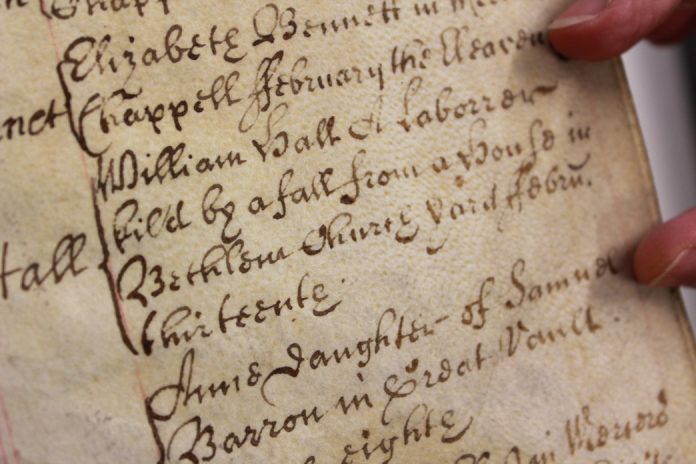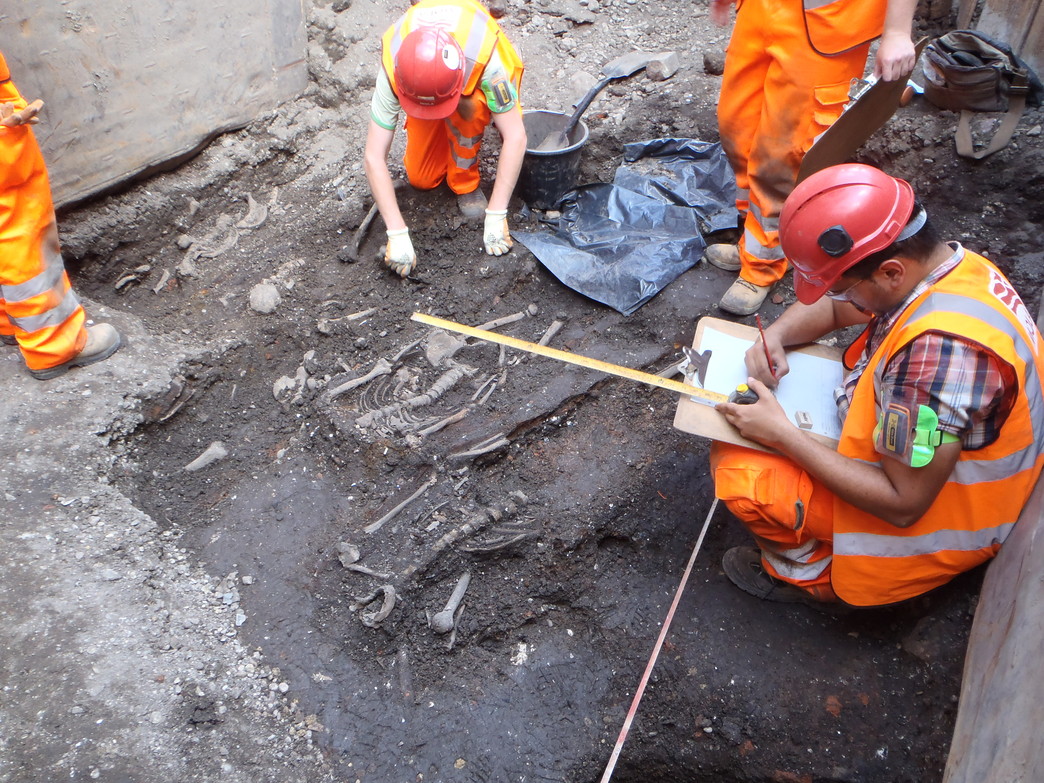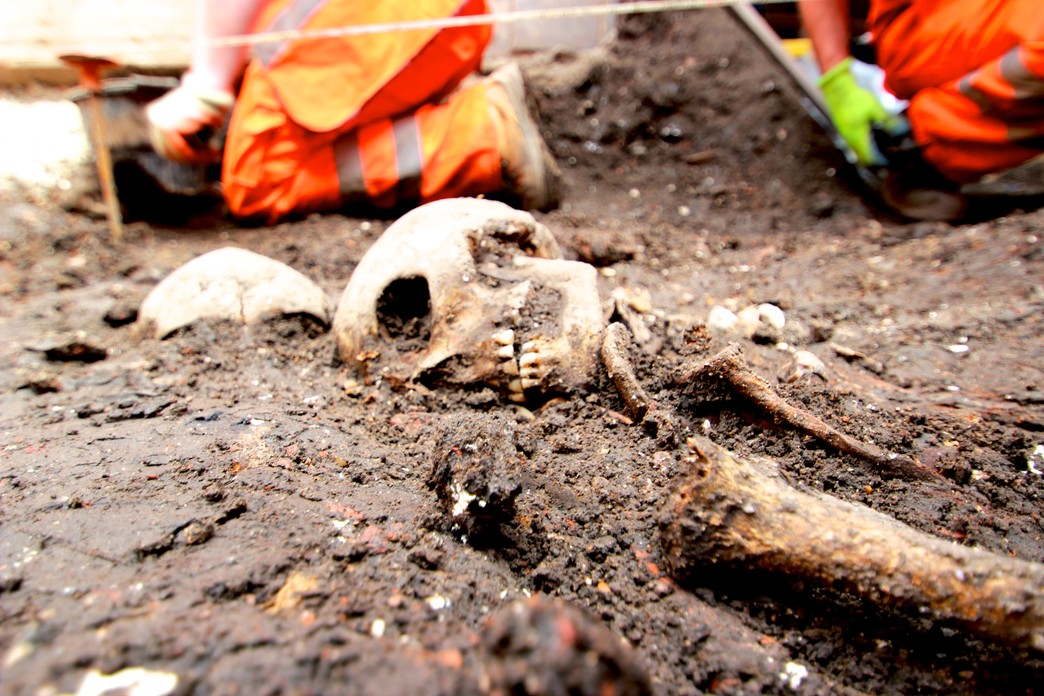- Crossrail-led research identifies names and backgrounds of over 5,000 people buried in the infamous Bedlam burial ground
- A notorious criminal murdered by the mob; political activists and plague victims among those found to have been buried beneath Liverpool Street in central London
- Excavation of a further 3,000 skeletons to begin at Bedlam site in March – Currently, MOLA are recruiting for other excavation work at Barts
- Recent discoveries include a plague tombstone from 1665. Click here to the database.
In June last year Crossrail invited 16 volunteers to scour parish records from across the capital to create the first extensive list of people buried at Bedlam in the 16th and 17th Centuries. The resulting database, published today, will inform Crossrail’s archaeological excavation of the eastern entrance of Liverpool Street Crossrail station, which begins in March and will see around 3,000 skeletons excavated. It also sheds light on a tumultuous period of London’s history.
According to the research a Dr John Lamb (also known as Lam or Lambe), an astrologer and advisor to the First Duke of Buckingham, is among those buried at the site. Lamb was said to have been stoned to death by an angry mob outside a theatre in 1628 following allegations of rape and black magic. Others identified in the research include victims of riots by ‘Fanatiques,’ noted in the diaries of Samuel Pepys in January 1661.
Plague was the most common listed form of death, followed by infant mortality and consumption. The burial ground was established in 1569 to help parishes cope with overcrowding during outbreaks of plague and other epidemics. Crossrail workers recently discovered the gravestone of Mary Godfree who died in September 1665, as a result of the ‘Great Plague’ which peaked that year.
Jay Carver, Lead Archaeologist at Crossrail said: “This research is a window into one of the most turbulent periods of London’s past. These people lived through civil wars, the Restoration, Shakespeare’s plays, the birth of modern industry, plague and the Great Fire. It is a real privilege to be able to use Europe’s largest construction project to uncover more knowledge about this fascinating period of history. Our heartfelt thanks go to the volunteer researchers, who have contributed immensely to Crossrail’s legacy.”
The archaeological excavations at Liverpool Street are undertaken by MOLA (Museum of London Archaeology) on behalf of Crossrail. Scientific analysis of up to 3,000 skeletons will provide new insights into the lives and deaths of early modern Londoners. The upcoming dig is also expected to uncover medieval and Roman artefacts and help piece together centuries of history. After excavation the skeletons will be reburied on consecrated ground.
To date Crossrail has found more than 10,000 artefacts spanning 55 million years of London’s history across over 40 construction sites. It is the UK’s largest archaeology project, carefully programmed in advance to ensure delivery of the new east west railway on time and within budget.
Liverpool Street is one of 10 new Crossrail stations being built in central and southeast London. When the TfL-run Crossrail service is fully open in 2019, it will give commuters easy access to destinations across London and the South East including Canary Wharf and Heathrow.
The research database can be found at www.crossrail.co.uk/bedlamregister
The Bedlam burial ground
The Bedlam burial ground, also known as Bethlem and the New Churchyard, was the first in London not associated with a parish church and was in existence from 1569 to at least 1738. It is located at the western end of Liverpool Street and got its name from the nearby Bethlehem Hospital, which housed the mentally ill.
The burial ground did not keep its own burial records. Instead the City’s parish churches recorded which of their parishioners were buried at Bedlam in their own records, which are now largely held in the London Metropolitan Archives. Crossrail is inviting the public to contribute to the research by sending in any information they have about the burial ground or those buried there to bedlamrecords@crossrail.co.uk. People from as far afield as Australia have already done so.
Many people buried at Bedlam were on the fringes of society. They were often interred there because they were not associated with any parish or religious institution or could not afford the fee for a Churchyard burial. Common occupations included servants, maids, tailors, shoemakers and watermen, although middle class guilds such as butchers and goldsmiths were also buried there. Many different ethnicities are represented, reflecting a globalising City.
Although they have not yet been discovered in the Crossrail research, others believed to be buried at Bedlam include Robert Lockyer, a young soldier in Oliver Cromwell’s New Model Army executed for his involvement in the Bishopgate mutiny, John Lilburne, an English political ‘Leveller’ during the English Civil Wars and Lodowicke Muggleton, a controversial religious writer and founder of the Muggletonian movement.
Preliminary excavations at the site on behalf of Crossrail have already uncovered close to 400 graves.
16 volunteers took part in the project and received help and training to investigate the historical archives under the supervision of Crossrail archaeologist Marit Leenstra. The records of 124 parish churches in the City of London were consulted.



